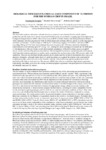Use este identificador para citar ou linkar para este item:
http://www.alice.cnptia.embrapa.br/alice/handle/doc/577742| Título: | Biological nitrogen fixation as a key component of n nutrition for the soybean crop in Brazil. |
| Autoria: | HUNGRIA, M.  ARAUJO, R. S.   CAMPO, R. J.   |
| Afiliação: | MARIANGELA HUNGRIA DA CUNHA, CNPSo; Ricardo Silva Araujo, Total Biotecnologia, Curitiba, PR.; RUBENS JOSE CAMPO, CNPSo. |
| Ano de publicação: | 2009 |
| Referência: | In: WORLD SOYBEAN RESEARCH CONFERENCE, 8., 2009, Beijing. Developing a global soy blueprint for a safe secure and sustainable supply: proceedings. Beijing: Chinese Academy of Agricultural Sciences: Institute of Crop Science, 2009. Oral Presentations. WSRC 2009. 1 CD-ROM. Editado por Lijuan Qiu, Rongxia Guan, Jian Jin, Qijan Song, Shuntang Guo, Wenbin Li, Yuanchao Wang, Tianfu Han, Xiaobing Liu, Deyue Yu, Lianzhou Jiang, Deliang Peng. |
| Conteúdo: | The area under soybean cultivation in South America accounts for more than half of the world soybean production, and the high cost of mostly important N fertilizers has necessitated a cropping approach emphasizing biological nitrogen fixation (BNF). Most of the work on BNF in South America has been performed in Brazil, with continuous selection programs for both rhizobial strains and soybean cultivars, aiming at achieving superior symbiotic performance. Yields as high as 5,000 kg ha-1 without any supply of N-fertilizer, and rates of BNF exceeding 300 kg of N ha-1 have been obtained. Increases in grain yield (~8%) have also been obtained by reinoculation in soils showing up to 106 cells g-1 soil. Among the main challenges of research are the difficulties of introducing new efficient strains in soils showing high populations of Bradyhrizobium japonicum and B. elkanii strains established by previous inoculations. The incompatibility between inoculation and seed treatment with fungicides and micronutrients is another main constrain to the maximization of the BNF process under field conditions. There are no rhizobial-friendly products in the market and the in-furrow inoculation comes up as an attractive alternative, although higher doses of liquid inoculants are required. In relation to the seed-applied molybdenum (Mo), often also toxic to the rhizobia, both the foliar fertilization and the production of seeds enriched on Mo help to avoid toxicity. The success of BNF also relies on a well-built legislation to guarantee high-quality inoculants, as well as on a strong extension program to guarantee that good practices of inoculation are annually employed by farmers. |
| Thesagro: | Nitrogênio Soja |
| Palavras-chave: | Fixação |
| Tipo do material: | Artigo em anais e proceedings |
| Acesso: | openAccess |
| Aparece nas coleções: | Artigo em anais de congresso (CNPSO)  |
Arquivos associados a este item:
| Arquivo | Descrição | Tamanho | Formato | |
|---|---|---|---|---|
| id30101.pdf | 101.23 kB | Adobe PDF |  Visualizar/Abrir |









